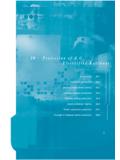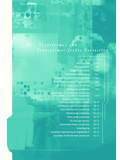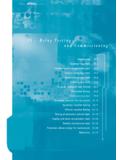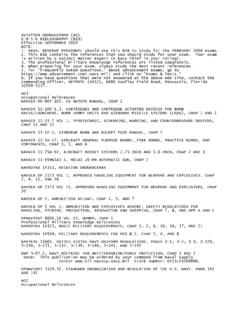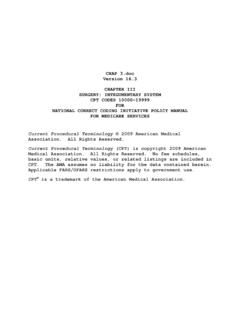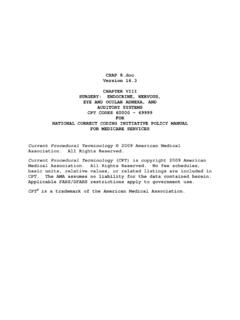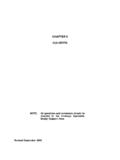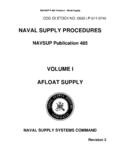Transcription of 4 Fault Calculations - fecime.org
1 Introduction phase Fault Calculations component analysis a three-phase networkEquations and network various types of faultsCurrent and voltage a system due to a faultEffect of system zero sequence quantitiesReferences 4 Fault CalculationsNetwork Protection & Automation Guide 31 INTRODUCTIONA power system is normally treated as a balancedsymmetrical three-phase network. When a Fault occurs,the symmetry is normally upset, resulting in unbalancedcurrents and voltages appearing in the network. The onlyexception is the three-phase Fault , which, because itinvolves all three phases equally at the same location, isdescribed as a symmetrical Fault . By using symmetricalcomponent analysis and replacing the normal systemsources by a source at the Fault location, it is possible toanalyse these Fault the correct application of protection equipment, it isessential to know the Fault current distributionthroughout the system and the voltages in differentparts of the system due to the Fault .
2 Further, boundaryvalues of current at any relaying point must be known ifthe Fault is to be cleared with discrimination. Theinformation normally required for each kind of Fault ateach relaying point is:i. maximum Fault currentii. minimum Fault through Fault currentTo obtain the above information, the limits of stablegeneration and possible operating conditions, includingthe method of system earthing, must be known. Faultsare always assumed to be through zero Fault THREE-PHASE Fault CALCULATIONST hree-phase faults are unique in that they are balanced,that is, symmetrical in the three phases, and can becalculated from the single-phase impedance diagramand the operating conditions existing prior to the Fault condition is a sudden abnormal alteration to thenormal circuit arrangement. The circuit quantities,current and voltage, will alter, and the circuit will passthrough a transient state to a steady state.
3 In thetransient state, the initial magnitude of the Fault currentwill depend upon the point on the voltage wave at whichthe Fault occurs. The decay of the transient condition,until it merges into steady state, is a function of theparameters of the circuit elements. The transient currentmay be regarded as a exponential current 4 Fault CalculationsNetwork Protection & Automation Guide 4 Fault Calculations 32 superimposed on the symmetrical steady state faultcurrent. In machines, owing to armature reaction,the machine reactances pass through 'sub transient' and'transient' stages before reaching their steady statesynchronous values. For this reason, the resultant faultcurrent during the transient period, from Fault inceptionto steady state also depends on the location of the faultin the network relative to that of the rotating a system containing many voltage sources, or havinga complex network arrangement, it is tedious to use thenormal system voltage sources to evaluate the faultcurrent in the faulty branch or to calculate the faultcurrent distribution in the system.
4 A more practicalmethod [ ] is to replace the system voltages by a singledriving voltage at the Fault point. This driving voltage isthe voltage existing at the Fault point before the the circuit given in Figure where the drivingvoltages are Eand E , the impedances on either side offault point Fare Z1 and Z1 , and the current throughpoint Fbefore the Fault occurs is :The voltage Vat Fbefore Fault inception is: V= E- I Z = E + I Z After the Fault the voltage Vis zero. Hence, the changein voltage is - V. Because of the Fault , the change in thecurrent flowing into the network from Fis:and, since no current was flowing into the network fromFprior to the Fault , the Fault current flowing from thenetwork into the Fault is:By applying the principle of superposition, the loadcurrents circulating in the system prior to the Fault mayIfIVZZZZ= =+() 1111'''''' IVZVZZZZ= = +()11111''''''be added to the currents circulating in the system due tothe Fault , to give the total current in any branch of thesystem at the time of Fault inception.
5 However, in mostproblems, the load current is small in comparison to thefault current and is usually a practical power system, the system regulation issuch that the load voltage at any point in the system iswithin 10% of the declared open-circuit voltage at thatpoint. For this reason, it is usual to regard the pre-faultvoltage at the Fault as being the open-circuit voltage,and this assumption is also made in a number of thestandards dealing with Fault level an example of practical three-phase faultcalculations, consider a Fault at Ain Figure With thenetwork reduced as shown in Figure , the load voltageat Abefore the Fault occurs is:Figure : V= E IFor practical working conditions, E Iand E I. Hence E E V. Replacing the driving voltages E and E by the loadvoltage Vbetween Aand Nmodifies the circuit as shownin Figure (a).The node Ais the junction of three branches.
6 In practice,the node would be a busbar, and the branches arefeeders radiating from the bus via circuit breakers, asshown in Figure (b). There are two possible locationsfor a Fault at A; the busbar side of the breakers or theline side of the breakers. In this example, it is assumedthat the Fault is at X, and it is required to calculate thecurrent flowing from the bus to network viewed from ANhas a driving pointimpedance |Z1| = current in the Fault + ++ 099122525 ''Figure : Network with Fault at FNFZ'1Z''1 IVE'E''Figure : Reduction of typicalpower system '' 'Network Protection & Automation Guide 33 4 Fault CalculationsLet this current be per unit. It is now necessary tofind the Fault current distribution in the various branchesof the network and in particular the current flowing fromAto Xon the assumption that a relay at Xis to detectthe Fault condition.
7 The equivalent impedances viewedfrom either side of the Fault are shown in Figure (a).Figure currents from Figure (a) are as follows:From the right: From the left: There is a parallel branch to the right of A1212760 , current in ohm branchand the current in ohm branchTotal current entering Xfrom the left, that is, from AtoX, is + = and from Bto equivalent network as viewed from therelay is as shown in Figure (b). The impedances oneither side = = circuit of Figure (b) has been included becausethe Protection Engineer is interested in these equivalentparameters when applying certain types of SYMMETRICAL COMPONENT ANALYSIS OF A THREE-PHASE NETWORKThe Protection Engineer is interested in a wider variety offaults than just a three-phase Fault . The most commonfault is a single-phase to earth Fault , which, in LVsystems, can produce a higher Fault current than a three-phase Fault .
8 Similarly, because protection is expected tooperate correctly for all types of Fault , it may benecessary to consider the Fault currents due to manydifferent types of Fault . Since the three-phase Fault isunique in being a balanced Fault , a method of analysisthat is applicable to unbalanced faults is required. It canbe shown [ ] that, by applying the 'Principle ofSuperposition', any general three-phase system ofvectors may be replaced by three sets of balanced(symmetrical) vectors; two sets are three-phase buthaving opposite phase rotation and one set is vector sets are described as the positive, negativeand zero sequence sets equations between phase and sequence voltages aregiven below:..Equation + +=++=+ + 12021201220= = =120563370 : Network with Fault at node ANAVBAX(b) Typical physical arrangement of node Awith a Fault shown at X(a) Three - phase Fault diagram for a Fault at node ABusbarCircuit Figure : Impedances viewed from (a) Impedance viewed from node A(b) Equivalent impedances viewed from node XNetwork Protection & Automation all quantities are referred to the reference phaseA.
9 A similar set of equations can be written for phaseand sequence currents. Figure illustrates theresolution of a system of unbalanced a Fault occurs in a power system, the phaseimpedances are no longer identical (except in the case ofthree-phase faults) and the resulting currents andvoltages are unbalanced, the point of greatest unbalancebeing at the Fault point. It has been shown in Chapter 3that the Fault may be studied by short-circuiting allnormal driving voltages in the system and replacing thefault connection by a source whose driving voltage isequal to the pre- Fault voltage at the Fault point. Hence,the system impedances remain symmetrical, viewed fromthe Fault , and the Fault point may now be regarded as thepoint of injection of unbalanced voltages and currentsinto the is a most important approach in defining the faultconditions since it allows the system to be representedby sequence networks [ ] using the method ofsymmetrical Positive Sequence NetworkDuring normal balanced system conditions, only positivesequence currents and voltages can exist in the system,and therefore the normal system impedance network is apositive sequence a Fault occurs in a power system, the current in theEEaEaEEEaEaEEEEEab cabcabc12220131313=++()=++()=++() Fault branch changes from 0to Iand the positivesequence voltage across the branch changes from Vto V1.
10 Replacing the Fault branch by a source equal to the changein voltage and short-circuiting all normal driving voltagesin the system results in a current Iflowing into thesystem, and:..Equation Z1is the positive sequence impedance of thesystem viewed from the Fault . As before the Fault nocurrent was flowing from the Fault into the system, itfollows that I1, the Fault current flowing from thesystem into the Fault must equal - I. Therefore: V1= V- I1 the relationship between positive sequence currentsand voltages in the Fault branch during a Figure , which represents a simple system, thevoltage drops I1 Z1 and I1 Z1 are equal to ( V- V1)where the currents I1 and I1 enter the Fault from theleft and right respectively and impedances Z1 and Z1 are the total system impedances viewed from either sideof the Fault branch. The voltage Vis equal to the open-circuit voltage in the system, and it has been shown that V E E (see Section ).
